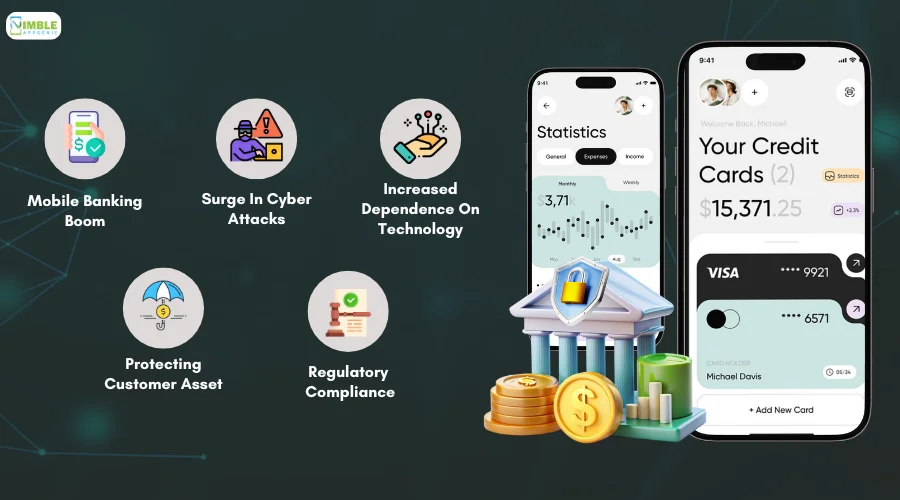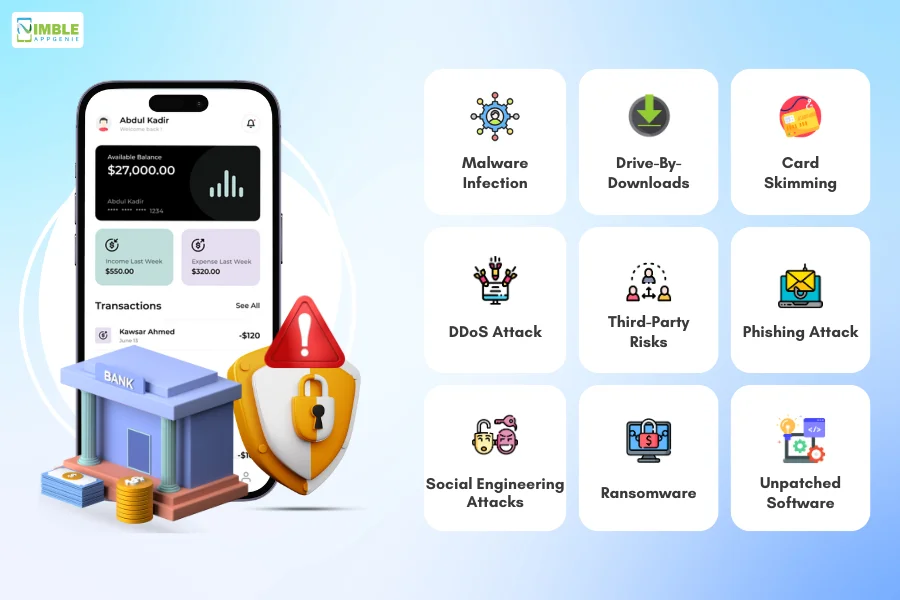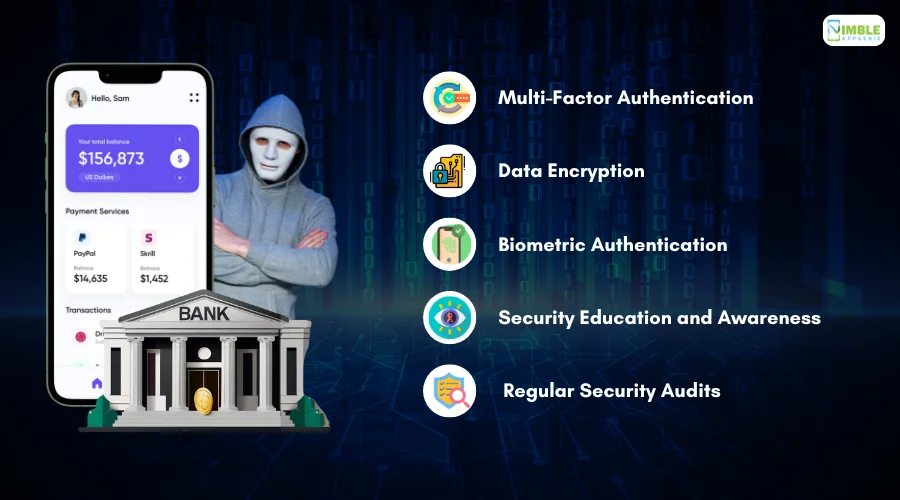A staggering 35,900,145,035 records have been compromised across 9,478 reported incidents.
Such a high number of data breaches shows how much cyber-security plays an important role in our lives.
Since financial gain is one of the top reasons for cybercrime, the banking sector packed with valuable data becomes one of the prime targets for data breaches.
Recognizing the critical need for robust security, experts have emphasized the importance of strong standards of mobile banking security for financial institutions.
In light of this, let’s delve into security risks troubling mobile banking and explore the preventive measures banks can implement to strengthen their digital barricades.
However, before we dive in, it’s crucial to understand the driving force behind the surge in digital and mobile banking security.
Overview of Mobile Banking Security Issues
Before we jump into to know about security vulnerabilities troubling mobile banking, let’s take a moment to grasp the seriousness of the situation.
The following statistics paint a concerning picture, highlighting the need for robust security measures.
-
- 1 in 10 small businesses face cyber-attacks annually, highlighting their susceptibility.
- A shocking 37% of employees incorporate their employer’s name in their passwords, creating easily guessable weaknesses.
- The recent Facebook breach impacted a staggering 540 million accounts, showcasing the potential scale of data loss.
- 60% of small businesses don’t survive a cyber-attack, underlining the severe consequences.
-
- A whopping 93% of data breaches are driven by financial gain, emphasizing the profit motive of attackers.
- A concerning 56% of Americans are unaware of the actions to take after a data breach, hindering their ability to respond effectively.
- Phishing attacks are considered the biggest cyber threat affecting 30% of small businesses, highlighting their prevalence and impact.
- Financial institutions have a concerning trend of exposing sensitive data. On average, a staggering 449,855 sensitive files are exposed within these organizations, with a shocking 36,004 accessible to everyone!
- It takes an average of 233 days to identify and contain a breach for a financial institution, leaving sensitive information vulnerable for extended periods.
- Perhaps most worryingly, 74% of financial and insurance attacks specifically target compromising clients’ personal details.
Rise of Security in the Banking Industry
The rise of security in the banking industry is a direct response to the increasing threats posed by the digital revolution. This is why there is a huge need to work on security.
Let’s see some more reasons why mobile banking app security is important:

1. Mobile Banking Boom
Due to the growing adoption and convenience of digital banking, mobile wallets and other financial services have become the norm.
This shift has created a vast pool of sensitive data open for cybercriminals. Now, imagine so much data open to unauthorized access can definitely result in a huge breach.
This also increases the need to increase the safety of the app.
2. Surge In Cyber Attacks
Cyberattacks are becoming more common than ever.
Hackers are constantly developing new methods, and malware to exploit the weaknesses in computer systems and steal user data.
As a result, if they have a successful attack on any banking app, it can result in devastating consequences, resulting in financial losses, reputational damage, and even identity theft for customers.
This is why it’s important to leverage mobile banking security measures to save users from such data theft.
3. Increased Dependence On Technology
Banking Apps are currently going through a huge transformation in recent decades.
While these advancements have made our lives easier than ever by offering convenience and efficiency, they also create new vulnerabilities.
This is another reason why mobile banking app security is important because banks now manage huge amounts of sensitive customer data online, making them prime targets for cybercriminals.
4. Protecting Customer Asset
Banking apps are supposed to guard user data and financial information.
Strong security measure helps prevent unauthorized access to accounts and avert any kind of fraudulent transactions.
This will create a sense of safety and build the trust of users in your app, making it grow even bigger.
5. Regulatory Compliance
Now and then, there are several security regulations that are launched by law to protect user data and ensure the security of the financial system.
A robust security measure is the need of the hour for banks to stay up-to-date as per market requirements to comply with these regulations and avoid hefty fines.
If you want to create an app like Monzo and make it successful in the market, data and app security should be your top priority. You might have understood this with the points given above.
What Are the Most Common Digital Banking Security Risks?
Now, as we are planning to learn about top mobile banking security issues, this section will equip you with the best knowledge.
Understanding these threats empowers you to make informed decisions and safeguard the finances of users and apps. Let’s explore the top challenges:

➤ Malware Infection
Malware, short for malicious software, includes viruses, worms, Trojans, Ransomware, and Spyware designed to infiltrate or damage any system.
Such software has the capability to wreak havoc on devices. Moreover, they can steal data, install other malware, or disrupt operations.
These malicious programs often infiltrate systems through:
➤ Phishing Attack
Deceptive emails or messages are masked as legitimate sources such as banks and social media to trick you into clicking malicious links or downloading any attachments.
Once you do that, they get access to personal information, financial information, and sometimes even control to your complete control.
➤ Drive-By-Downloads
Visiting any compromised websites can unknowingly download malware into your system. And, these can create huge issues for you later on.
This could allow them to steal information, spy on your activity, or even install additional bugs to corrupt your system.
➤ Social Engineering Attacks
It’s a tactic basically to exploit human psychology and manipulate individuals into revealing their confidential information or performing actions that comprise security.
Studies suggest social engineering attacks account for a significant portion, with estimates as high as 98% of cyber-attacks.
Attackers can use fear and scare strategies, a sense of urgency, or mimic a trusted source to gain your trust.
One common way is scammers often call people claiming from a bank and threaten them to close their account right away if they don’t complete their information.
Don’t fall for such tricks! Real banks will never pressure you for sensitive information over the phone.
➤ Card Skimming
Card Skimming has become quite popular in the last few years.
This involves criminals installing devices on ATMs or point-of-sale terminals to capture card information, enabling them to clone cards or make unauthorized transactions.
They accomplish such thefts by installing a skimming device at ATMs, Gas Pumps, or POS in stores.
Once these devices capture the data encoded on the magnetic stripe on the back of your card, then they use it to create counterfeit cards for fraudulent transactions.
Credit card theft topped identity theft in 2023 with 426,000 complaints. Seeing such staggering numbers, apps need best practices for maintaining mobile banking security.
➤ Ransomware
Ransomware is a malicious software program that encrypts a victim’s files, essentially holding them hostage.
Let’s simplify this.
Imagine a digital kidnapper locking away all your important documents and other data. To regain access, the attacker demands a ransom payment, typically in cryptocurrency like Bitcoin which can be difficult to trace.
It infects your device through different means including email; malicious website downloads, or infected attachments.
Once installed, the ransomware scans your device and encrypts your valuable files; this makes data inaccessible for you, meaning locking you out of your own data.
One of the famous banking apps such as Capita was recently hit by a ransomware attack that caused significant disruption. This definitely shows the need to pay attention to your mobile banking security.
➤ DDoS Attack
Imagine there is a group of protestors standing at the gate, blocking the entrance to a store. Meaning, stopping legitimate customers from entering.
This is what DDoS Attack (Distributed Denial-of-Service Attack) does in the digital world.
Similar to the above example, Attackers overwhelm the banking app or website with a flood of junk traffic, making it completely inaccessible to real users.
As a result, this makes a website unavailable to users leading to a loss of your cost, damaging resources, and productivity. This can not only result in downtime but can also put pressure on your banking app cost for mitigation efforts.
➤ Unpatched Software
One of the biggest challenges while creating a mobile banking app is to keep their software or app up-to-date.
As you know outdated software or apps won’t be able to survive in current times.
Technology is constantly changing; as a result, you should also change otherwise your banking app can be exploited by hackers in ways that tarnish your brand and user trust.
Regularly updating your operating system applications and firmware helps to patch these vulnerabilities and make sure your digital banking app is secure.
➤ Third-Party Risks
The modern app development process of a banking app relies heavily on third-party tools such as bill payment services or any budgeting tool.
But, do you know? There might be a hidden threat lurking under the surface- that’s third-party risks.
These are vulnerabilities introduced by integrating external services and functions into your app.
As a result, this can affect your banking app seriously, such as the third-party vendor you are taking services from might have weaker app security practices and this might result in compromising your user data.
As we have explored threats to mobile banking app security, it’s time that we explore ways to strengthen some app’s security posture.
How Banking Apps Can Combat Cyber-Attacks?
As, we got to know about the vulnerabilities of cyber-threats, time to know ways to mitigate such issues.
Fortunately, banks are actually taking action to combat these threats, let’s get to know along with some additional areas for improvement.

1] Multi-Factor Authentication
Banking apps like Revolut offer their customers multi-factor authentication as an additional layer of security.
This means providing multiple forms of verification such as passwords, and biometrics.
While multi-factor authentication (MFA) is a good strategy, it needs to be implemented properly for robust digital banking app security.
Encourage users to enable MFA and consider implementing adaptive authentication mechanisms that adjust security measures based on different factors such as device characteristics and location.
This will surely enhance the app’s security.
2] Data Encryption
Features of the banking app attract users to the platform.
Ensuring that your app is not only feature-rich but also secure will even enhance the quality of your app.
This can be achieved through data encryption.
You see, the app should make sure to keep sensitive information like account details, and transaction data encrypted, making it unreadable even if captured by hackers.
This ensures that whatever data is transferred including account credentials and information details are transmitted securely.
One tip to make mobile banking secure is to protect data both in transit and at rest, minimizing the risk of any type.
3] Biometric Authentication
Biometric authentication is actually the savior of banking apps.
It includes fingerprint scanners and facial recognition which offers a more secure and convenient login option compared to passwords.
For users, they are a more convenient and secure way to access their accounts. Around 81% of consumers trust biometrics for secure identity verification.
Moreover, security mobile banking can be taken further by expanding support for more options for biometrics such as voice recognition, and iris scanning.
Leveraging such options will give users confidence in the app’s security and bolster the overall security framework.
4] Security Education and Awareness
One of the best ways to stop such breaches is to aware people of mobile banking security best practices.
This will not only aware them of such scams but also increase their confidence in using digital banking services.
Banking Apps often provide security tips, alerts, and educational resources to help users recognize and mitigate potential cyber security threats.
However, they can enhance this understanding by offering interactive tutorials within the app to educate users about common attack paths and best practices for staying safe online.
5] Regular Security Audits
Regular security updates are necessary if you want to create a successful app like Chime.
Banking apps release regular updates to fix any vulnerabilities and discover weaknesses as well as address them. This enhances the overall experience for the user and makes the app successful in the long term.
You can also implement automated update mechanisms to make sure users are aware of the updated version and encourage them timely to minimize risks of any kind of exploitation.
These are some ways, one can make sure to increase mobile banking security and help them to enjoy a seamless experience.
Nimble AppGenie: Your Partner in Securing Mobile Banking Apps
If you’re planning to build your banking app, keep the above-mentioned security recommendations in mind.
You would require a skilled development team that has worked on the creation of a banking app in the past. If you don’t have it, consider outsourcing your banking app work to experts.
Nimble AppGenie, the best mobile banking app development company has expert professionals in developing banking apps.
We’ve produced numerous fintech apps that are excelling in the global marketplace.
So, hire a mobile app developer from us to get started today!
Conclusion
Digital banking offers undeniable convenience, but it also introduces cybersecurity risks. Fortunately, banks are not sitting idle.
They’re employing various strategies to fight these threats, including multi-factor authentication, data encryption, biometric authentication, and user education.
However, there’s always room for improvement. By continuously enhancing their security posture, banks can create a safe and secure environment for managing finances.
Remember, cybersecurity is a shared responsibility. Both banks and users have a role to play in safeguarding financial information in the digital age.
FAQs
Digital banking faces threats like malware attacks, social engineering scams, card skimming, ransomware attacks, DDoS attacks, and unpatched software vulnerabilities.
Enable multi-factor authentication, use strong and unique passwords, be cautious of suspicious emails and links, avoid using public Wi-Fi for banking, and keep your banking app and device software updated.
Banks are implementing measures like data encryption, biometric authentication, regular security updates, and user education programs.
Mobile banking can be safe if you practice good security habits and choose a reputable bank with robust security measures.
Contact your bank immediately if you suspect unauthorized transactions or breaches.

Niketan Sharma, CTO, Nimble AppGenie, is a tech enthusiast with more than a decade of experience in delivering high-value solutions that allow a brand to penetrate the market easily. With a strong hold on mobile app development, he is actively working to help businesses identify the potential of digital transformation by sharing insightful statistics, guides & blogs.
Table of Contents






No Comments
Comments are closed.